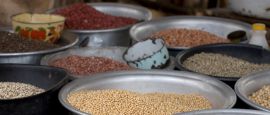Accra, Ghana's bustling capital, offers a mix of historical, cultural, and modern attractions. Key sights include the Independence Arch and Black Star Square, symbols of Ghana's liberation from colonial rule. Visit Jamestown, a historic neighbourhood with colonial-era architecture and vibrant street art. The Kwame Nkrumah Mausoleum honours Ghana's first president, while the W.E.B. Du Bois Centre explores Pan-African history.
Ghana things to see and do
These UNESCO World Heritage Sites offer insight into the transatlantic slave trade. Visitors can explore the dungeons, cells, and storied courtyards while reflecting on their historical impact.
Kakum is a stunning rainforest reserve famous for its Canopy Walkway, a series of suspension bridges offering a breathtaking view of the forest treetops. The park is home to diverse wildlife, including monkeys, antelope, and over 300 bird species, although sightings can be rare due to the dense forest. Explore the nature trails to learn about the flora and fauna, and stop by the visitor centre for guided tours that provide insights into the park's conservation efforts and biodiversity.
Kumasi is the historic capital of the Ashanti Kingdom. The Manhyia Palace Museum offers insights into the Ashanti monarchy, while the Prempeh II Jubilee Museum explores Ashanti culture and artefacts. Kumasi is also a great place to discover traditional Ashanti textiles at a kente weaving village or learn about goldsmithing at nearby craft villages.
This picturesque crater lake, near Kumasi, is a tranquil spot ideal for relaxation, canoeing, and exploring local fishing villages. It holds cultural and spiritual significance for the Ashanti people.
Mole is Ghana's largest wildlife reserve. Visitors can see elephants, antelope, warthogs, and baboons, and guided walking and driving safaris are available. The Mole Motel provides stunning views of the park's savannah and watering holes, where wildlife gathers. For a cultural touch, nearby communities like Larabanga are worth a visit. They feature the Larabanga Mosque, one of West Africa's oldest and most historic mosques.
Mount Adaklu, one of Ghana's tallest mountains at 580m (1,900 ft) high, is a rewarding destination for travellers seeking an off-the-beaten-path experience. The climb to the summit offers breathtaking views of lush landscapes and opportunities to spot local wildlife. Surrounding villages, like Helekpe, provide a chance to experience traditional Ghanaian rural life.
Nzulezo is a unique village built on stilts over Lake Tadane in the Western Region. Accessible by canoe, it offers a fascinating glimpse into the lifestyle of the community that has lived here for centuries.
In northern Ghana, this sacred pond is home to tame crocodiles revered by locals. Visitors can interact with these crocodiles under the supervision of guides, which is an unforgettable cultural and wildlife experience.
The Western Region of Ghana has idyllic and pristine beaches that are perfect for relaxation and exploration. Busua Beach is a lively hotspot with golden sands, excellent surf schools, and fresh seafood, making it a favourite among locals and tourists alike. For a more tranquil escape, Cape Three Points, Ghana's southernmost tip, offers unspoiled beaches and eco-friendly stays, with opportunities for turtle watching during the nesting season. Ankobra Beach, near Axim, is a serene retreat with eco-conscious resorts and a peaceful atmosphere, ideal for those seeking solitude.
The Volta Region offers diverse attractions, including the lush Amedzofe mountains, the Tafi Atome Monkey Sanctuary, and the iconic Adome Bridge. It's a paradise for hikers and nature enthusiasts.
Located near the Togo border, Wli is Ghana's highest waterfall and a stunning natural wonder. The surrounding Agumatsa Wildlife Sanctuary adds to the appeal, with hiking trails and opportunities to see bats and birdlife.
Do you have any Feedback about this page?
© 2025 Columbus Travel Media Ltd. All rights reserved. No part of this site may be reproduced without our written permission, click here for information on Columbus Content Solutions.








 You know where
You know where